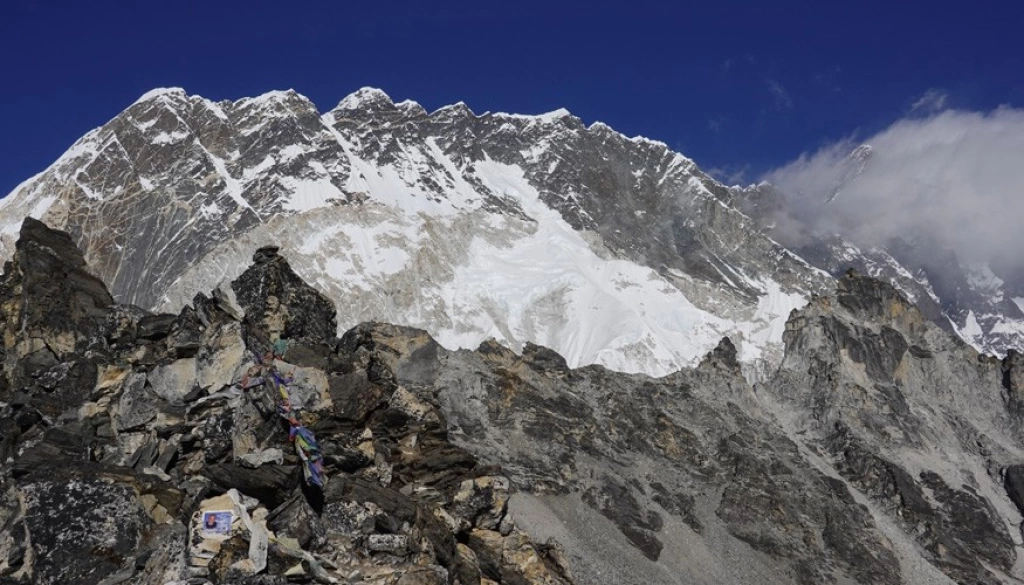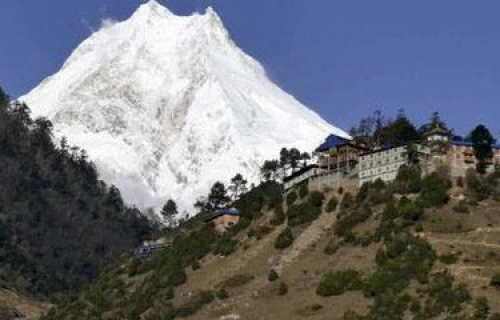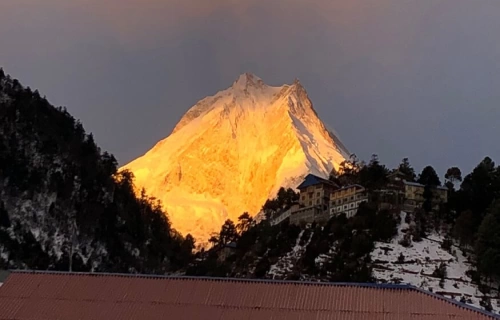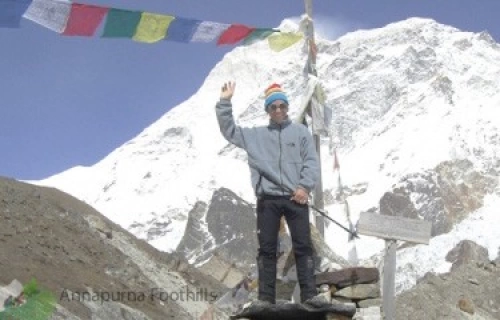About Lhotse Expedition
Lhotse, the 4th highest mountain in the world, stands at 8516m, immediately south of Mount Everest; the summits of Everest and Lhotse are connected by the South Col, a vertical ridge that never drops below 8000m. The long east-west crest of Lhotse has three summits: Lhotse Main 8516m, Lhotse East (Middle), 8413m, and Lhotse Shar 8383m.
The standard climbing route for Lhotse follows the Everest South Col route up to the famous Yellow Band just beyond Everest's Camp III, 7300m, on the Lhotse Face.
The West Face of Lhotse is marked by a deep scar, an icy gully known as the Lhotse Couloir; the couloir is the crucial test to the Lhotse climb, mainly because the climbing conditions of the couloir are affected by weather and seasonal snowfall.
This Lhotse Expedition demands advanced skill climbing on steep, exposed and technical skill and altitude experience is mandatory. It is an ideal climb designed for previous Everest climbers or those who have proved confident on 7000-meter climbs.
The itinerary allows a caution acclimatization period at Base Camp where we spend time training, reviewing safety protocol and getting familiar with the terrain on the ice columns found at the lower edge of the Khumbu Icefall. We will practice secure movement using ladders and fixed rope as it is important to be able to move fairly quickly through the icefall. We can hone our mountaineering skills nearby objectives that are less dangerous than the icefall.
The Lhotse Expedition 2023 and 2024 itinerary coordinates with the Everest South Col expedition.Climbers should arrive in Kathmandu no later than April 05th 2023.
Getting to Base Camp:
While we shake off our jet-lag in Kathmandu, we make sure all our official work is complete, get a briefing from the Ministry of Tourism, and finalize our supplies. There is a good selection of local and international mountaineering equipment and clothing, so its a good chance to do some last minute shopping.
Our Lhotse Expedition begins in Lukla, a 40-minute flight from Kathmandu. Our expedition supplies will be carried to base camp by yaks, zokyos (yak hybrids) and porters, while we set off up the Khumbu Valley at a more leisurely pace, which allows our bodies to acclimatize. This gives us a chance to savour the natural wonder of the Khumbu, and the cultural beauty of the local Sherpa inhabitants.
On the way to EBC, we will stop at Tengboche Monastery to request a special blessing of the lama, who will perform a puja to implore the deities to bless our expedition members and equipment. We accept a scarf, or khata, with the eight lucky Buddhist signs, as a symbol of the lamas blessing.
By the time we arrive in Everest Base Camp about 8 days later, the Sherpas will have our camp all set up.
Lhotse Expedition Route Description:
Base Camp, 5400m to Camp I, 5900m
On the first rotation we climb through the Khumbu Icefall to Camp I, 5900m, starting out before daybreak to maximize the hours before the sun starts heating the glacier. The Khumbu Icefall is a moving glacier, heavy with huge seracs and crevasses. A team of Sherpas called the Icefall Doctors continually maintain a path through this dangerous area with rope and ladders. To minimize the time spent on the Icefall, we avoid any unnecessary stops. The terrain levels out just before Camp I. We will likely pass by Camp I on successive climbs.
Camp I, 5900m to Camp II, 6500m
The following day we walk up the Western Cwm, a broad valley formed by the Khumbu Glacier, to Camp II, 6500m. There are deep crevasses, some marked with fixed ladders and some hidden by snow bridges. The sun is blinding here, as it reflects off the snow on every side of the valley. If there are no clouds it can be very warm here. We are surrounded by the towering flanks of Nuptse, Lhotse and Everests South West face. Here we spend two nights adjusting to the altitude and then move further up the Lhotse Face to Camp III, 7300m.
Camp II, 6500m to Camp III, 7300m
From Camp II, we start climbing the Lhotse Face. It can be a challenge to get a foothold with our crampons in this wall of rock hard blue ice and packed snow. There are lines fixed into the face with screws and anchors, but since there is just one line for ascending and one for descending, there can be a traffic jam on this section. We keep clipped into fixed line all the way to Camp III which is on a ledge about halfway up the Lhotse face.
Well spend one night here before descending back to Camp II then the next day back to Base Camp. We recover and prepare ourselves for the summit attempt while our Sherpa support team is preparing the high camps.
When a window of good weather appears we are ready to make a direct climb from Base Camp to Camp II and the next day to Camp III. The following day we make an early start to try and reach Camp IV, 7900m. We can use the remaining hours of the day to rest, as we need to depart around midnight for our summit push.
Camp III, 7300m to Camp IV, 7900m
A steep climb from Camp III takes us up to the Yellow Band, a layer of limestone that cuts through these mountains. There are fixed ropes to help us climb the Yellow Band; it is not so difficult, but at this altitude nothing is easy. Most climbers are using oxygen by this point. It can be extremely cold before the sun reaches, especially if there is a wind, but once the sun climbs over Lhotse, it burns through the thin atmosphere.
The Yellow Band is the landmark where we separate from the expeditions to Everest and veer to the right towards some rock shelves, which are known as the turtle shell. This rocky outcropping is where we establish Lhotse Camp IV, 7900m.
Camp IV, 7900m to Lhotse Summit, 8516m
Just above Camp IV we enter the 500-meter high gully of ice leading onto the final summit ridge. Narrow and as steep as 60 degrees in places, the Lhotse Couloir is the passage leads to the summit ridge. Once on the knife edge ridge, some tricky scrambling leads to the summit.
After reaching the summit climbers will descend to Camp II and the following day descend to Base Camp.
A Typical Lhotse Expedition
There is no fixed plan that works for all climbers and all seasons. Often, climbers will do two acclimatization rotations prior to the summit bid. That said, the final rotation schedule will be decided by factors such as the weather and the health of our expedition team members. It is crucial that everyone works as a team and communicates clearly.
The first rotation will begin after a week acclimatizing at Base Camp. We usually go to Camp I, 5950m, for a night, then to Camp II, 6400m for a couple nights, and spend one night in Camp III, 7470m before returning to Camp II for a night and finally back to EBC.
Guests at Base Camp
Except for Everest expedition members, no one is allowed to stay overnight in Base Camp. However, we want to inform you that we welcome family or friends of climbers who are interested in joining your expedition as far as Base Camp. Some of them may even be interested in one of the many treks in Everest Region, or a less challenging peak.
Consider Climbing Lobuche for Extra Acclimatization
For people with a sufficient time-frame, an excursion to nearby Lobuche Peak, 6119m, is a great way to ensure you are well acclimatized before you start the Lhotse Expedition.



